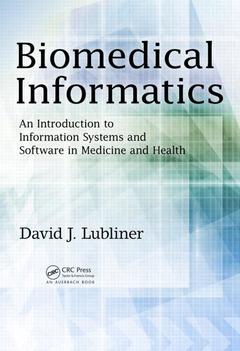Description
Biomedical Informatics
An Introduction to Information Systems and Software in Medicine and Health
Author: Lubliner David J.
Language: English
Subjects for Biomedical Informatics:
Keywords
Te Ch; HCAHPS Score; Medical informatics; Smart Phones; Healthcare informatics; Electronic Protected Health Information; Nursing informatics; HITECH Act; Programming for medical informatics; Personal Health Records; Pharmaceutical informatics; HCPCS Code; Cloud computing in healthcare; HCAHPS Survey; Tablet app design for EMR; Da Ta; Data; CDSS; Covered Entity; HIPAA Privacy Rule; EHR Implementation; Critical Care Unit; DICOM Standard; Wireless Medical Devices; SNOMED CT; White Blood Cells; HIEs; Title Iii; BMI; EHR System; Nis Database
· 17.8x25.4 cm · Hardback
Description
/li>Contents
/li>Biography
/li>
Medical informatics lies at the intersection of computer science and medicine, and understanding critical aspects of both fields provides for more proficient practitioners. Biomedical Informatics: An Introduction to Information Systems and Software in Medicine and Health supplies a cohesive narrative of the multidisciplinary concepts linking the field.
This complete medical informatics textbook begins by reviewing the IT aspects of informatics, including systems architecture, electronic health records, interoperability, privacy and security, cloud computing, mobile healthcare, imaging, data capture, and design issues. Next, the text provides case studies that demonstrate the roll out of electronic health records (EHRs) in hospitals.
The third section incorporates four anatomy and physiology lectures that focus on the physiological basis behind data captured in EHRs. Examples include detailed descriptions of the heart and electrical systems, lungs and alveoli, and oxygen exchange.
The book includes a primer on the theoretical concepts that underpin the science behind medical informatics, including an Anatomy & Physiology Essentials guide. It also contains a tutorial on application development to help students understand the tools for improving user interfaces for EHRs on mobile platforms.
The author uses a student-friendly organizational structure that supplies students with a clear demarcation between essential and optional material. The text supplies clear delineation between Level I, the basic concepts every biomedical informatics professional needs to master; Level II, applied concepts and examples; and Level III, advanced topics. This format allows undergraduate and graduate instructors and professionals in the field to focus quickly on the essential topics, and if interested, delve into Level III advanced topics.
The book includes links to documents and standards sources so students can explore each idea described in more detail. Instructor?s manual, solutions manual, videos, figure slides, and lecture slides are available upon qualified course adoption.
Introduction to Biomedical Informatics. Framework for Implementing the U.S. Medical Records Infrastructure. Electronic Health Records. Data Interoperability. Security. Telehealth. Medical Sensors. Imaging. Ethics. Critical Care Nursing Perspective on the Electronic Health Record. Healthcare Management Information Technology in the Full Service Facility. Future Directions for Biomedical Informatics. Appendices: Application Development for Electronic Health Records–Mobile Applications Development. Mobile Applications Development.
David J. Lubliner is a member of the faculty at a northeast university, where he coordinates a Medical Informatics program he developed a decade earlier. With a Ph.D. in Information Systems and graduate degrees in Biomedical Engineering and Computer Science, he is currently part of a team developing a handheld medical scanner.
Prior to teaching, he worked for 10 years at a Fortune 500 company as a divisional vice president of an architecture—computer security group. Before that Lubliner worked as an engineer on the Patriot missile system.




